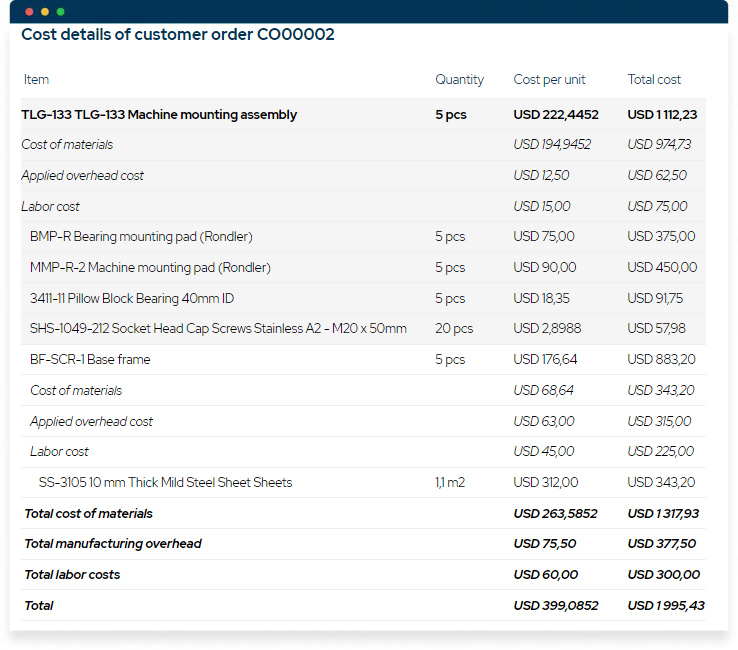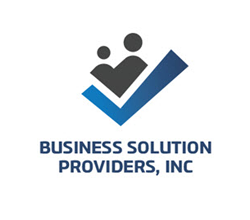Product costing is a necessity not only for accountants but also for managers. Understanding the costs related to manufacturing your products gives you the chance to determine optimal selling prices and take steps toward cost reduction. Here is a simple guide to performing product costing.

- What is Product Costing?
- Types of manufacturing costs
- Product Costing in 7 easy steps
- Activity-based Product Costing
- Product Costing with an ERP/MRP software
- Key takeaways
What is Product Costing?
Product costing is the process of calculating the costs incurred with manufacturing a single product. This total cost includes the consumption of raw materials and components, labor, and overhead allocated to a sole unit.
For accountants, product costing is essential for inventory valuation and for calculating the cost of goods sold. Managers, however, use product costing as a jumping-off point for deciding which products to manufacture as well as for pricing the manufactured products. After calculating the cost per unit, you can use various pricing methods to determine an optimal selling price for the product. The cost per unit also serves as a manufacturing performance metric to help keep tabs on production costs.
Types of manufacturing costs
Every business operation incurs both direct and indirect production costs. Direct costs are expenses directly related to manufacturing the product (raw materials, shop floor employees) while indirect costs are incurred with auxiliary activities, materials, and services, i.e. overhead.
In a manufacturing company, direct costs are made up of raw material costs, packaging costs, and factory floor employee salaries, i.e. of people and items that are directly involved in the manufacture of goods. Indirect or overhead costs, however, include indirect materials such as fastenings, glue, lubricants, etc.; indirect labor costs for supervisors, production planning, QA, and maintenance workers, and other manufacturing overhead expenses (rent, utilities, insurance, etc.).
Product Costing in 7 easy steps
Although there are several different ways to approach product costing, you can follow these seven basic steps in any situation.
- Identify the cost object. If your company manufactures standard products, you can take a single product as the cost object. If you build custom products, then you can also use job costing to determine the costs related to a full order.
- Track the direct costs of individual items. Simply add together all direct material and direct labor costs that go into making a particular product.
- Pool together the overhead costs. These include indirect materials (lubricants, fasteners, and other goods used for manufacturing that are not tracked), indirect labor (production planning, maintenance, quality assurance and control, supervisors, shop floor janitors, etc.), and manufacturing overhead (rent, utilities, insurance, depreciation, etc.).
- Pick the overhead cost allocation base. You may just pool together the indirect costs and apply it evenly over all your products. But for better accuracy and decision-making, you should allocate the overhead according to how resource-heavy a product is. In this case, more overhead is allocated to those items that take more time or materials to make, and less overhead is allocated to those products that consume less. Generally, either machine hours or labor hours are used as the overhead cost allocation base.
- Calculate the overhead allocation rate. If you apply the same amount of overhead to each product, you can skip this step. However, if you use machine or labor hours, then use the following formula:
Overhead allocation rate = Total overhead / Total hours
For example, if the total overhead incurred over a month is estimated at $24,000 and production workers put in a total of 800 hours of work, the overhead allocation rate would be:
24,000 / 800 = $30/hour - Allocate the overhead costs. If you apply the same amount of overhead to each product, and you produced 600 products during the period, the formula would be:
Overhead cost per product = Total overhead / Total products
With the numbers from the previous example, the overhead per product would be:
24,000 / 600 = $40
If you use the overhead allocation rate, however, you would also need to know how much time was spent on making different products. Let’s say you make three distinct products: tables, chairs, and coffee tables. Producing a table takes 1.25 hours, a chair takes 0.75 hours, and a coffee table takes 1 hour to finish.
Therefore, the overhead allocated to each product would be:
Table: 1.25 x 30 = $37.50
Chair: 0.75 x 30 = $22.50
Coffee table: 1 x 30 = $30 - Calculate the total cost. To do this, just take the direct costs of a product and add them to the overhead allocated to the product.
Let’s say the table consists of a tabletop that costs $30 and four table legs that cost $20 per set. The direct material costs are therefore $50. Furthermore, the labor cost of the workers assembling and finishing the table is $30/hour, with one person working on the table at a time. As a table takes 1.25 hours to finish, the labor cost per table is:
$30 x 1.25 = $37.50
Now, adding together the direct costs and the applied overhead per table, we will get the cost per unit.
CPU = Direct labor + Direct materials + Overhead
$37.50 + $50 + $37.50 = $125
The production costs incurred with the manufacture of one table total $125.
As you have arrived at the cost per unit of your products, you can use these numbers as a jumping-off point for determining their optimal selling prices.
Activity-based Product Costing
There are several costing systems that differ in how the overhead allocation is done. First, you have to decide which costs you will treat as direct and indirect costs. Secondly, you can decide on having one or multiple cost pools with different cost allocation bases. Instead of the simple approach taken above, you can use a two-stage costing system like activity-based costing where costs are divided between departments according to the activity through which the costs are incurred.
For example, you could opt for allocating overhead to sectors such as inspections, material handling, and purchasing. These are your activity allocation pools. The allocation bases, however, may differ in each of those. For instance, the allocation base for the inspection pool could be the number of inspections performed on a product; for the material handling pool, the number of material handling interactions each product needs to arrive at the end of the production line; for the purchasing pool, the number of purchase orders needed to procure the materials or components for making the product.
Simple products need fewer inspections, fewer material handling transactions, and fewer purchase orders and therefore the overhead applied to those items will be lower than that of the more complex products.
Product Costing with an ERP/MRP software
Product costing can be made much easier with the help of manufacturing software. A proper ERP/MRP system can help you easily track the costs incurred with manufacturing products. The best solutions initially estimate and later, after production, accurately calculate the cost per unit based on some of those inputs.
For example, when issuing a quote for a customer, you can estimate what the costs will be and see how they are broken down.

As manufacturing progresses, direct materials, direct labor, and manufacturing overhead are calculated in real-time by the software system itself according to the reporting inputs from workers.
Once manufacturing is completed, all costs are automatically calculated together for a clear overview. Plus without any extra work, you get reports that tell you exactly how the cost per unit is changing over time.
Following the journey of a product from raw material suppliers through production to the customer, modern MRP software helps you record each direct and indirect cost, material handling transaction, inspection, and various other events, helping you achieve full traceability as well as transparency in your costs.
The manufacturing accounting module of these types of systems can help you track your assets and liabilities, calculate the cost of goods sold, profit or loss, and much more.
Key takeaways
- Product costing is the process of calculating the costs incurred with manufacturing a single product.
- For accountants, product costing is essential for inventory valuation and for calculating the cost of goods sold. Managers use product costing as a jumping-off point for pricing the manufactured products and taking steps toward cost reduction.
- Production costs are divided into direct and indirect costs: direct costs are materials and labor that are directly involved in the manufacture of the product; indirect costs are overhead for rent, utilities, indirect materials like adhesives and fastenings, and indirect labor like production supervisors, planners, procurement, etc.
- To find the cost per unit, overhead must be allocated to the specific product and added to the product’s direct costs. This can be done in several different ways.
- Use an ERP/MRP system to automatically perform product costing and track your costs per unit.

